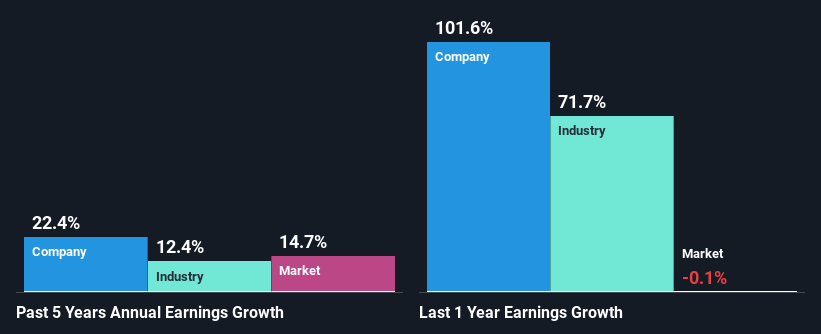Is PSC Insurance Group Limited's (ASX:PSI) Recent Stock Performance Influenced By Its Fundamentals In Any Way?

Most readers would already be aware that PSC Insurance Group's (ASX:PSI) stock increased significantly by 20% over the past three months. Given that stock prices are usually aligned with a company's financial performance in the long-term, we decided to study its financial indicators more closely to see if they had a hand to play in the recent price move. Specifically, we decided to study PSC Insurance Group's ROE in this article.
Return on equity or ROE is an important factor to be considered by a shareholder because it tells them how effectively their capital is being reinvested. In short, ROE shows the profit each dollar generates with respect to its shareholder investments.
View our latest analysis for PSC Insurance Group
How Do You Calculate Return On Equity?
The formula for ROE is:
Return on Equity = Net Profit (from continuing operations) ÷ Shareholders' Equity
So, based on the above formula, the ROE for PSC Insurance Group is:
14% = AU$65m ÷ AU$473m (Based on the trailing twelve months to December 2023).
The 'return' refers to a company's earnings over the last year. One way to conceptualize this is that for each A$1 of shareholders' capital it has, the company made A$0.14 in profit.
What Has ROE Got To Do With Earnings Growth?
We have already established that ROE serves as an efficient profit-generating gauge for a company's future earnings. We now need to evaluate how much profit the company reinvests or "retains" for future growth which then gives us an idea about the growth potential of the company. Assuming everything else remains unchanged, the higher the ROE and profit retention, the higher the growth rate of a company compared to companies that don't necessarily bear these characteristics.
PSC Insurance Group's Earnings Growth And 14% ROE
To start with, PSC Insurance Group's ROE looks acceptable. And on comparing with the industry, we found that the the average industry ROE is similar at 13%. This probably goes some way in explaining PSC Insurance Group's significant 22% net income growth over the past five years amongst other factors. However, there could also be other drivers behind this growth. For instance, the company has a low payout ratio or is being managed efficiently.
Next, on comparing with the industry net income growth, we found that PSC Insurance Group's growth is quite high when compared to the industry average growth of 12% in the same period, which is great to see.

Earnings growth is a huge factor in stock valuation. The investor should try to establish if the expected growth or decline in earnings, whichever the case may be, is priced in. Doing so will help them establish if the stock's future looks promising or ominous. Is PSI fairly valued? This infographic on the company's intrinsic value has everything you need to know.
Is PSC Insurance Group Using Its Retained Earnings Effectively?
The high three-year median payout ratio of 93% (implying that it keeps only 7.3% of profits) for PSC Insurance Group suggests that the company's growth wasn't really hampered despite it returning most of the earnings to its shareholders.
Moreover, PSC Insurance Group is determined to keep sharing its profits with shareholders which we infer from its long history of eight years of paying a dividend. Existing analyst estimates suggest that the company's future payout ratio is expected to drop to 65% over the next three years. Accordingly, the expected drop in the payout ratio explains the expected increase in the company's ROE to 18%, over the same period.
Summary
On the whole, we do feel that PSC Insurance Group has some positive attributes. Namely, its high earnings growth, which was likely due to its high ROE. However, investors could have benefitted even more from the high ROE, had the company been reinvesting more of its earnings. As discussed earlier, the company is retaining hardly any of its profits. That being so, a study of the latest analyst forecasts show that the company is expected to see a slowdown in its future earnings growth. Are these analysts expectations based on the broad expectations for the industry, or on the company's fundamentals? Click here to be taken to our analyst's forecasts page for the company.
New: Manage All Your Stock Portfolios in One Place
We've created the ultimate portfolio companion for stock investors, and it's free.
• Connect an unlimited number of Portfolios and see your total in one currency
• Be alerted to new Warning Signs or Risks via email or mobile
• Track the Fair Value of your stocks
Have feedback on this article? Concerned about the content? Get in touch with us directly. Alternatively, email editorial-team (at) simplywallst.com.
This article by Simply Wall St is general in nature. We provide commentary based on historical data and analyst forecasts only using an unbiased methodology and our articles are not intended to be financial advice. It does not constitute a recommendation to buy or sell any stock, and does not take account of your objectives, or your financial situation. We aim to bring you long-term focused analysis driven by fundamental data. Note that our analysis may not factor in the latest price-sensitive company announcements or qualitative material. Simply Wall St has no position in any stocks mentioned.
About ASX:PSI
PSC Insurance Group
Provides diversified insurance services in Australia, the United Kingdom, rest of Asia, Hong Kong, New Zealand, Ireland, Bermuda, and Vietnam.
Excellent balance sheet with limited growth.
Market Insights
Community Narratives




